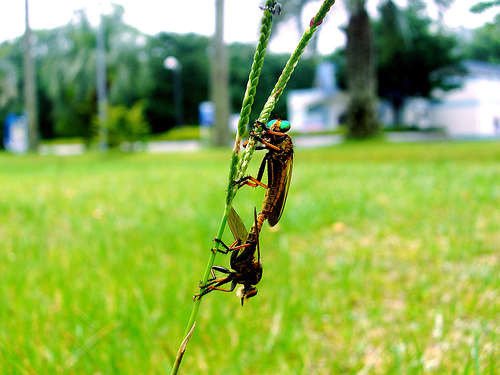August 31, 2008
Towards Biodiversity Conservation in Japan
Keywords: Newsletter
 Creative Commons. Some Rights Reserved. Photo by David Jez
Creative Commons. Some Rights Reserved. Photo by David JezThe Japanese archipelago, with a north-south length of about 3,000 kilometers, consists of thousands of islands. It has four distinct seasons, dramatic changes in altitude from seashore to high mountains, and geologic processes both connecting and isolating it from the Asian mainland. With an area of around 38 million hectares, it encompasses varied habitat and growing conditions with an abundance of biota.
The number of known species in Japan is estimated to be over 90,000, or, if those unclassified are counted, there are over 300,000. Japan also features a higher ratio of endemic species than other countries. This would be about 40 percent of all land-dwelling mammals or vascular plants, 60 percent of insects and 80 percent of amphibians. Among the advanced countries, Japan has the only habitat for wild monkeys, and many medium- and large-sized wild animals such as bears and deer are also found in the country.
The Nature of Japan
http://www.env.go.jp/nature/np/pamph4/natu_eng.pdf
A diverse marine environment exists around Japan because of the Kuroshio (or Japan Current), Oyashio (or Kurile Current), and Tsushima Current flowing around the long archipelago, extending north and south. The length of its coastline is about 35,000 kilometers, compared to the entire circumference of the Earth at the equator, about 40,000 kilometers. Diverse ecosystems can be seen on the complex shorelines, tidal lands, seaweed beds, and coral reefs.
As a result, a dramatically greater variety of fish live in seas close to Japan than in the Mediterranean basin or the west coast of North America, which both lie at the same latitudes as Japan. The seas off Japan boast rich biodiversity, with 50 of 112 species of underwater mammals and about 3,700 (about 25 percent) of an estimated 15,000 species of marine fish on Earth.
Japan was selected to host the Tenth Meeting of the Conference of the Parties (COP10) to the Convention on Biological Diversity (CBD) in 2010.
Biological diversity means the variability among living organisms, and it includes diversity in ecosystems, species, and genetic resources. Every organism is different, and as a result of a long history of evolution, well-balanced diversity has been maintained.
A sense of crisis, however, over the loss of tropical forests and the extinction of species has been heightened worldwide since the 1980s. This fear led to the adoption of the CBD in 1992. Japan became a party to the convention in 1993, and it came into effect in late December of the same year. In accordance with the convention, the Japanese government created the National Biodiversity Strategy. The first strategy was formulated in 1995, the second one in 2002, followed by the third one in November 2007.
The National Biodiversity Strategy is reviewed every year. Since the formulation of this strategy, various initiatives have been implemented to restore ecosystems specific to individual areas. For example, the Law for the Promotion of Nature Restoration was enacted in 2002, leading to the establishment of Nature Restoration Committees in many areas across the country. Some laws, including the Law for the Protection of Cultural Properties and the Urban Green Space Conservation Law, were revised to enhance biodiversity conservation. Furthermore, model projects have been implemented to, for example, conserve and restore the natural environment in "satochi" and "satoyama," which are areas with rich biodiversity near human settlements in the countryside.
Law for the Promotion of Nature Restoration
http://delicious.com/japanfs/biodiversity
Under the third national strategy, global warming, was added to the list of three major threats to biodiversity, namely, (1) human activities such as land developments, (2) poor management that causes degradation of the natural environment in satochi and satoyama, and (3) exotic species brought in from elsewhere by humans.
The 3rd National Biodiversity Strategy and Action Plan
http://www.cbd.int/doc/meetings/nbsap/nbsapcbw-seasi-01/
other/nbsapcbw-seasi-01-jp-nbsap-en.pdf
The third national strategy presented a vision of Japan's future environment in terms of biodiversity, by coming up with the "100-Year Program," which is literally a 100-year program to recover the nation's ecosystems that have been damaged in the past century. The national strategy also developed the following four strategic policies that are to be implemented in about five years, placing an emphasis on the need for the involvement of local governments and the private sector:
- Raise public awareness on biodiversity
- Rebuild harmonious relationships between humans and the natural environment in local areas
- Ensure linkage between forests, farmland, rivers, and the sea
- Act with a global perspective
The second part of the third national strategy is the "Action Plan," in which about 650 concrete measures are described. These measures have, for the first time, some numerical targets and the names of relevant ministries and agencies. The numerical targets include "raise public awareness on biodiversity from 30 percent to 50 percent or more" and "increase the number of Ramsar sites in Japan by 10."
The National Biodiversity Strategy encourages local governments to develop their own strategies. Although not many local governments have formulated their strategies yet, some took action in line with the national strategy. One example is Chiba Prefecture, which created a comprehensive and systematic strategy to conserve biodiversity.
There is also a growing interest in biodiversity among Japanese companies. In the Environmental Reporting Guidelines (last revised in June 2007), the Ministry of the Environment specified "conservation of biodiversity and sustainable use of biological resources" as one of the information/index items expected to be included in corporate environmental reports.
Specific items related to biodiversity include the following:
- Guidelines, goals, plans, implementation process, and results of biodiversity conservation activities
- Major effects caused by business operations and assessment of these effects
- Major effects caused by the procurement of raw materials, and assessment of these effects
- Information on the use of land, including its own properties
- Conservation and recovery programs and their purposes
Following these guidelines, more and more companies refer to biodiversity in their CSR/sustainability reports.
At the Ninth meeting of the Conference of the Parties to the Convention on Biological Diversity, or COP 9, held at Bonn, Germany, in May 2008, the Business and Biodiversity Initiative, proposed by the German government, was inaugurated. The aim of this initiative is to involve the private sector more closely in achieving the CBD's objectives. By signing a leadership declaration, businesses will be visibly involved in supporting the convention through voluntary commitments regarding concrete contributions to its objectives.
COP 9
http://www.cbd.int/convention/cops.shtml
Business and Biodiversity Initiative
http://www.bmu.de/english/nature/downloads/doc/40635.php
Thirty-four companies around the world participated in the signing ceremony at COP 9. Among them were nine Japanese companies, including JFS corporate supporters such as Aleph Inc., Ricoh Co. Ltd., and Fujitsu Limited.
In April 2008, a group of Japanese private companies established the Japan Business Initiative for Conservation and Sustainable Use of Biodiversity (JBIB) to promote information exchange and studies in the field of biodiversity. The founders include Ajinomoto Co., a JFS corporate supporter.
Japan Business Initiative for Conservation and Sustainable Use of Biodiversity (JBIB) http://www.jbib.org/en/
Various initiatives to mainstream biodiversity in the economy are also underway in Japan. The distribution of Forest Stewardship Council-certified lumber and Marine Stewardship Council-certified seafoods is proactively being promoted, and some consumers' cooperative unions are conducting research on species and the ecosystems in rice paddies, aiming to promote organic farming, which enriches biodiversity.
Some companies started their activities to help preserve rainforests where they obtain materials for their business. NEC Corporation, one of JFS's corporate members, is making efforts to promote the revitalization of rice paddies for preserving biodiversity in collaboration with the Asaza Fund, a nonprofit organization. The company has implemented its unique initiative to raise employees' environmental awareness in parallel with its employee welfare program.
NEC Rice Paddy Building Project
http://www.nec.co.jp/eco/en/annual2006/03/3-14-21.html
The Japanese government plans to create guidelines to encourage the business sector to initiate activities for biodiversity preservation, in collaboration with business groups and companies.
Many people still do not fully grasp the significance of the word "biodiversity." They usually associate corporate environmental activities with waste reduction and global warming countermeasures. We strongly hope, however, that not only COP 10 of the CBD, scheduled to be held in Nagoya in 2010, but also the preparations and related campaigns for the conference, will provide a driving force for people and businesses in Japan to more deeply understand biodiversity and pursue its preservation.
(Written by Junko Edahiro)
Related
"JFS Newsletter"
- 'Good Companies in Japan' (Article No.4): 'Eightfold Satisfaction' Management for Everyone's Happiness
- "Nai-Mono-Wa-Nai": Ama Town's Concept of Sufficiency and Message to the World
- 'Yumekaze' Wind Turbine Project Connects Metro Consumers and Regional Producers: Seikatsu Club Consumers' Co-operative
- Shaping Japan's Energy toward 2050 Participating in the Round Table for Studying Energy Situations
- 'Good Companies in Japan' (Article No.3): Seeking Ways to Develop Societal Contribution along with Core Businesses






